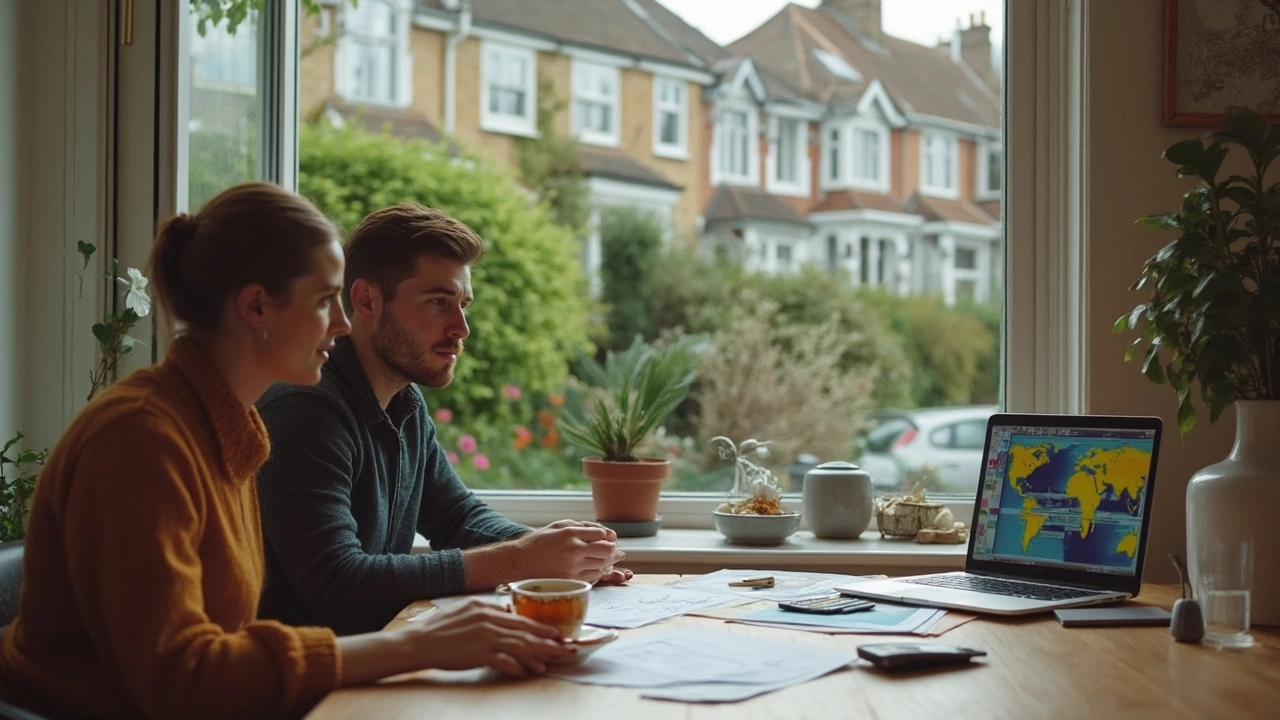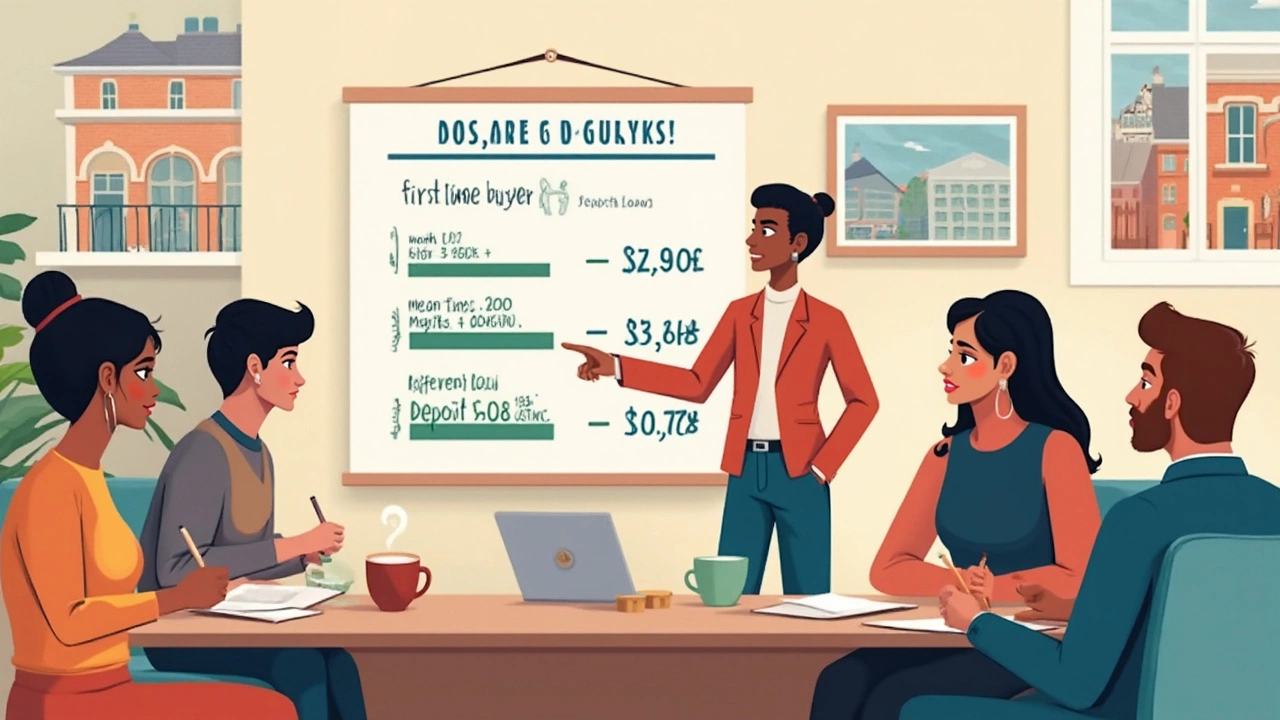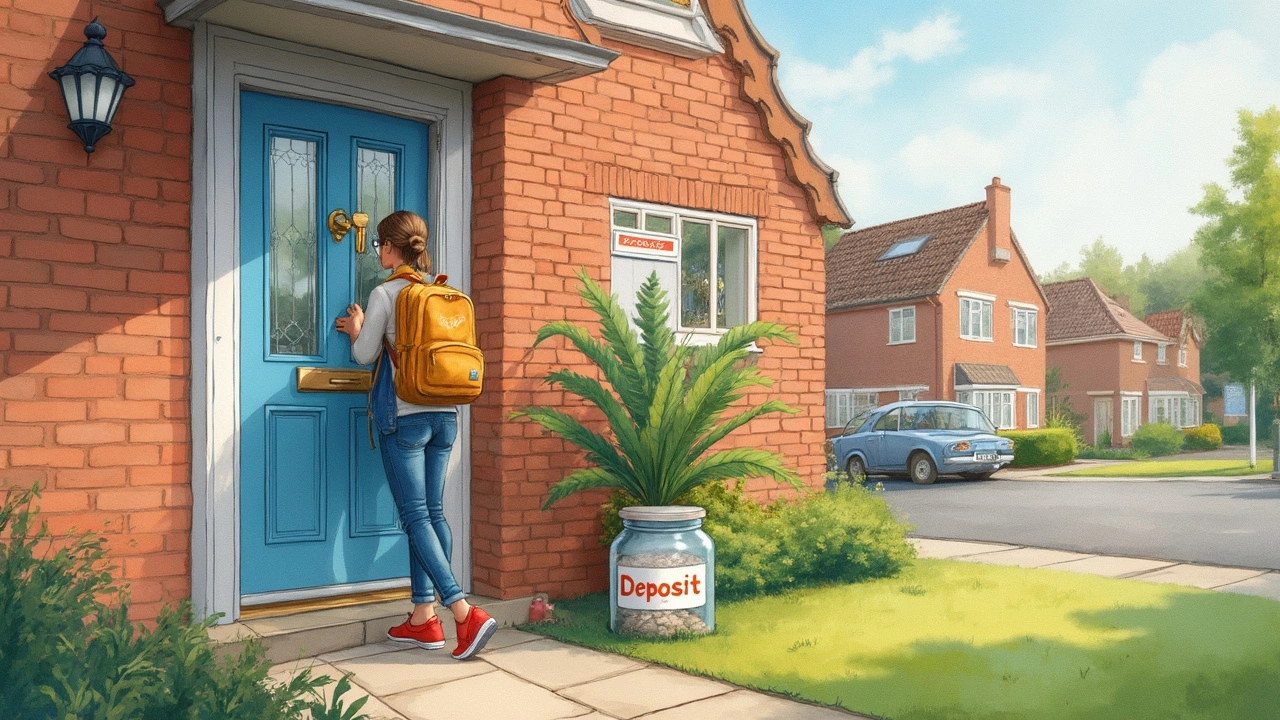Minimum Down Payment on a House: What First-Time Buyers Need to Know
 May, 27 2025
May, 27 2025
Think you need to save up a massive chunk of cash before you can buy a house? You’re not alone. Most people picture a huge pile of money when they hear “down payment.” The truth is, plenty of first-time buyers snag their home with way less than the old-school 20% down. Some options let you get the keys with as little as 3% down—or nothing at all in rare cases.
It really comes down to what kind of loan you qualify for and how much risk the lender wants to take. Let’s be real: Lenders aren’t all handing out the same deals. What you’ll actually need can shift a lot depending on your credit score, your income, and the type of house you’re eyeing. Here’s the kicker: In 2025, more buyers than ever are getting creative with their down payments, and banks are making different options available for folks who never thought they could buy a home.
If you’re stressing about saving up, or confused about what the minimum really means, stick around. There’s so much more you can do (and way less you might need) to make your first home a reality.
- Understanding Minimum Down Payment Requirements
- Different Loan Types and Their Down Payments
- How Your Down Payment Affects Your Mortgage
- Tips for Saving Your Down Payment
- Mistakes to Avoid as a First-Time Homebuyer
Understanding Minimum Down Payment Requirements
First things first: your down payment is just the cash you pay upfront when buying a house, separate from the loan. It’s usually the biggest hurdle for first-time buyers. But here’s the surprise—most lenders don’t need 20% down. In fact, the national average for a first-time buyer in the U.S. sits around 6% these days. Some folks get in for even less with help from special programs or by picking certain types of loans.
The absolute minimum down payment depends on both the kind of mortgage you use and the rules set by the bank or lender. Here’s a practical breakdown for 2025:
| Loan Type | Lowest Down Payment |
|---|---|
| Conventional | 3% |
| FHA (Federal Housing Administration) | 3.5% |
| VA (for Eligible Veterans) | 0% |
| USDA (rural buyers) | 0% |
If you’ve got a solid credit score and steady income, you might qualify for those lowest rates. For a $300,000 house, 3% down means $9,000 upfront. FHA’s 3.5% would be $10,500. Not as scary as it sounds, especially compared to saving up $60,000 for a 20% down payment.
Lenders also care about your debt-to-income ratio, job history, and credit. All these factor into what they’ll accept as a minimum down payment—and what kind of interest rate you’ll get. If your credit’s rocky or you’ve had job gaps, you may get asked for more cash up front, or you may need to look into repair strategies first.
Here’s what matters most: the down payment minimum can be surprisingly low if you know where to look and how to prep your application. Don’t let that big 20% myth keep you renting longer than you need to.
Different Loan Types and Their Down Payments
Figuring out how much cash you’ll need upfront starts with picking the right loan. Every loan comes with its own rules for down payments, and as a first time buyer, knowing these can save you both stress and money.
Here’s a breakdown of the most common loan types and how low their down payment requirements can go:
- Conventional Loans: These loans are super popular and often come from banks or private lenders. You’ve probably heard that you need 20% down for these, but that’s not true for everyone. Many first-time buyers can get approved with as little as 3% down if they’ve got decent credit.
- FHA Loans: Backed by the Federal Housing Administration, FHA loans are designed for folks who don’t have perfect credit. You can get started with just 3.5% down, and sometimes even less if you qualify for down payment assistance programs.
- VA Loans: If you've served in the military, VA loans from the Department of Veterans Affairs might let you buy a house with 0% down. That’s right—no down payment at all, if you qualify.
- USDA Loans: These are for buyers looking at homes in rural areas, and just like VA loans, they can get you in for zero down. Not everyone qualifies, but it’s worth checking if your target area counts as “rural.”
Check out this cheat sheet. It shows what kind of down payment you might need for each loan type in 2025:
| Loan Type | Minimum Down Payment | Who Qualifies? |
|---|---|---|
| Conventional | 3% (first-time buyers) | Solid credit, steady income |
| FHA | 3.5% | Lower credit scores, steady work |
| VA | 0% | Veterans/active duty service members |
| USDA | 0% | Low/moderate-income buyers in rural areas |
Lenders are strict about rules—just having the cash isn’t enough. Your credit score, work history, and sometimes even where you want to live all play into it. Be ready to show how you’ll handle a mortgage. Don’t just assume you’ve got to save 20%—there are ways to get in the door for a whole lot less if you pick the best loan fit for your situation.

How Your Down Payment Affects Your Mortgage
Let’s talk brass tacks: the size of your down payment doesn’t just get your foot in the door—it changes everything about your mortgage. Put down a bigger amount, and you’ll usually score a smaller loan, a better interest rate, and cheaper monthly payments.
For first-time buyers, it’s easy to assume you just pay whatever the bank says, but more money upfront gives you some real power. Here’s what actually happens when you change your down payment:
- Down payment size directly lowers your loan balance. A $300,000 house with a 5% down payment means borrowing $285,000, but with 15% down, you only borrow $255,000. That means less paid in interest over the life of the loan.
- Lenders worry less when you have more skin in the game, so bigger down payments often mean lower interest rates.
- If your deposit is under 20%, expect to pay something called private mortgage insurance (PMI). That’s an extra monthly fee just because you’re putting down less cash.
Here’s a quick look at how the numbers can play out. Check out this table using a typical $300,000 home and a 30-year fixed-rate loan, just to see the difference:
| Down Payment | Loan Amount | Estimated Monthly Payment* | Private Mortgage Insurance (PMI) |
|---|---|---|---|
| 3% ($9,000) | $291,000 | $2,075 | $160 |
| 10% ($30,000) | $270,000 | $1,925 | $110 |
| 20% ($60,000) | $240,000 | $1,710 | None |
*Monthly figures include principal and interest, with an estimated 6.5% rate (as of 2025), before taxes and insurance.
So, the smaller the down payment, the larger your loan payment and the more you’ll fork over in fees. PMI typically costs 0.5% to 1.5% of the loan amount per year, so that adds up fast. Aim for a higher down payment if you want real breathing room in your budget. But if you can only swing the minimum, that’s okay—just be sure you know how much extra you’ll be paying over time so there are no nasty surprises later.
Tips for Saving Your Down Payment
Getting together enough for a down payment can feel like trying to fill a pool with a bucket. But there are proven moves you can make to actually see your savings grow—without cutting all the fun from your life. The real trick is thinking in concrete steps, not wishful thinking.
First off, set a clear savings goal based on the house price you’re after. For example, if you’re looking at a $350,000 starter home and need just 3% down, your target is $10,500. If you shoot for 5%, it's $17,500. Breaking it down like this keeps you focused.
Here’s a short table to give you a feel for what you’d need:
| Home Price | 3% Down | 5% Down | 10% Down |
|---|---|---|---|
| $250,000 | $7,500 | $12,500 | $25,000 |
| $350,000 | $10,500 | $17,500 | $35,000 |
| $500,000 | $15,000 | $25,000 | $50,000 |
Now, let’s talk strategy:
- Open a dedicated savings account: Park your down payment funds where you won’t accidentally spend them. Online accounts often pay better interest than the big banks on the corner.
- Automate your savings: Set up an automatic transfer—say $150 every Friday—so you build up your stash without thinking about it. Small, regular hits make a bigger difference than you’d guess.
- Slash recurring expenses: Streaming services, monthly subscriptions, eating out twice a week—it adds up. Trim a few, and send that cash straight to your house fund.
- Score extra cash: Got a side hustle, bonus, or tax refund? Drop all or part of it into your home savings. People who do this can shave months off their timeline.
- Look for down payment assistance: Tons of city and state programs give first-time buyers a serious leg up. Some offer grants, others have loans with low or no interest. Search what’s available in your area—these programs can make meeting the down payment so much easier.
Here’s a cool fact: According to the National Association of Realtors, almost 29% of first-time buyers in 2024 used gifts or loans from family or friends for part of their down payment. No shame in asking—sometimes it’s the boost that gets you the home you want.
Finally, don’t let perfect stand in the way of good enough. You don’t always need 20% down to get started. Plenty of folks buy their first homes with a lower down payment and work their way up from there.

Mistakes to Avoid as a First-Time Homebuyer
First time buyers face a ton of obstacles—and it’s way too easy to trip up. Some mistakes can stick with you for years (and cost real money), so it’s smart to know what to steer clear of before you even start shopping.
- Down payment confusion. A lot of people think they need exactly 20% down, and wait forever to save it up. You can usually put down a lot less—sometimes just 3% if you qualify for a conventional loan, or even zero with a VA or USDA loan. Don’t let old myths hold you back.
- Skipping loan pre-approval. If you start checking out houses before getting pre-approved, you’re basically shopping blind. A pre-approval letter shows sellers you’re a serious buyer and tells you exactly how much house you can afford. Miss this step, and you risk heartbreak—or wasting time on homes out of your budget.
- Forgetting about extra costs. There’s way more to a house than a down payment. Closing costs, home insurance, property taxes, inspections, even moving expenses—they all add up. Rule of thumb: Budget at least 2-5% of the home’s price just for closing costs.
- Not checking your credit report. Never assume your credit score is fine. Pull your free credit report (you can get one per year from each bureau), scan for errors, and tackle any issues. Better credit means better rates, which saves you big bucks in the long run.
- Ignoring first-time buyer programs. Each state and even some local governments offer programs with low down payments, grants, or help with closing costs. If you skip research here, you might be leaving free money on the table.
- Letting emotions rule your choices. Don’t fall in love with a house you can’t afford just because it has a killer kitchen or a cool backyard. Stick to a price range that’s realistic for your finances, even if it means compromising on your wish list.
If you keep these mistakes in mind—and avoid them—you’re already way ahead of most first-time buyers. The home buying process gets a lot less scary (and expensive) when you stay informed and keep your expectations in check.